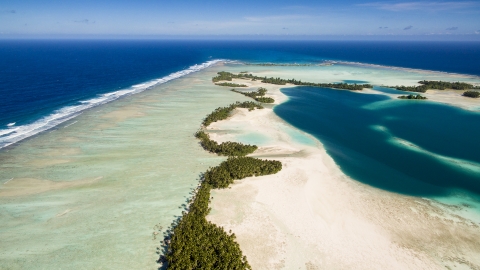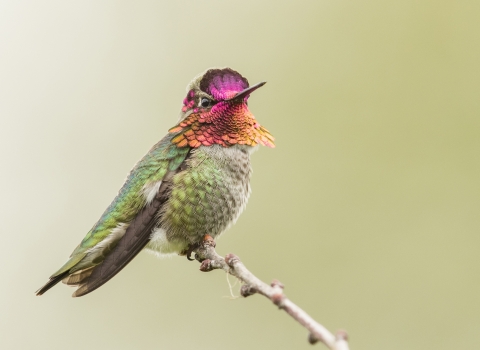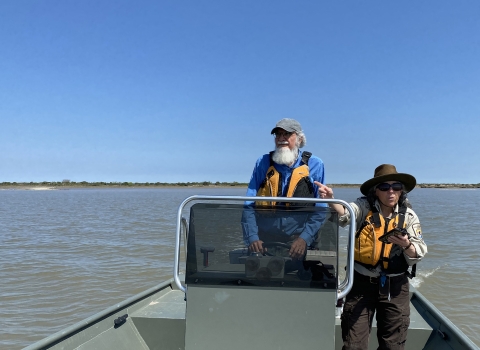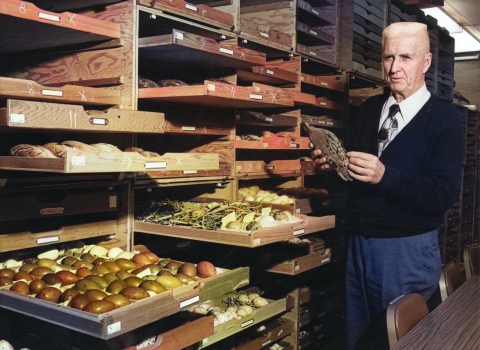By Jan Peterson, for the U.S. Fish and Wildlife Service
Stefan Kropidlowski lives a life of which budding adventurers and scientists dream.
After spending his childhood exploring his hometown of Neenah, Wisconsin, and graduating from the University of Wisconsin-Madison, Kropidlowski set off to see the world through the lens of research and conservation. Now deputy superintendent of the Pacific Islands Heritage Marine National Monument, Kropidlowski talks about his journey and the challenges of working for months at a time on remote islands and current projects they have going at the monument, which is 490,000 square miles of open ocean, coral reef, and island habitats – nearly five times the size of all U.S. National Parks combined and almost twice the size of Texas.
What inspired you to pursue a career in science and conservation?
I’ve always had an affinity for animals and wildlife. After earning my bachelor’s degree, I went out to explore the world. I had some amazing opportunities to do field research in places like Tasmania, Thailand, Antarctica, the Arctic, and the Northwest Hawaiian Islands. As I was working in these amazing places, I began to feel that while the research was important, it wasn’t having much of a direct impact on conserving the species we were studying as I would have liked. I began to shift my focus from research to applied conservation biology and natural resource management. Getting to spend several seasons for the U.S. Fish and Wildlife Service as the steward of an entire island where you got to know every species and could make substantial improvements on the entire ecosystem really struck a chord with me and offered me a path to pursue that desire.
How did your career journey lead you to the farthest western edge of the U.S. Fish and Wildlife Service’s management reach?
My foot in the door was fortuitous. Truly. In 2002, I met a guy at a party in Hawaiʻi Volcanoes National Park where I was interning for U.S. Geological Survey at the time, and we hit it off. He said he was headed out to Pearl and Hermes Atoll for two months and was looking for someone to go with him. I jumped at the chance. I did the work out there, got introduced to the staff of what is now the Monuments of the Pacific office for the Service and also hit it off with them. Since then, I have gone to one or more remote refuge islands every year but one in the last 22 years. I made my way from volunteer to field tech, to crew lead, to operations coordinator, to Refuge Manager, to my current role as the Deputy Superintendent of PIHMNM.
What are some of your favorite career moments?
I’ve been really fortunate to have many of those. Each new animal sighting and new amazing landscape are all treasured moments. In terms of projects, I’ve contributed to: the first two Laysan duck translocations from Laysan to Midway Atoll National Wildlife Refuge; the first reintroduced maiapilo plants flourishing, flowering and fruiting on Laysan; successful eradication of yellow crazy ants from Johnston Atoll; rewilding the extinct-in-the-wild sihek (Guam kingfisher) to Palmyra; and building a demand for the use of conservation dogs in Hawaiʻi. I was also able to serve as the refuge manager of Palmyra Atoll for 10 years.
What are some of the challenges of working in such remote places?
The biggest challenge is no different than any other job: people. Some personalities are too big for a small island. Some people just are not meant to be on small islands in small groups for long periods of time. The difference from any other job is you are trapped with them day and night for long periods (up to nine months at my longest), and you cannot get a break from them to reset. It can have an effect on the entire tiny community. But it makes it that much more precious when you find the right kind of flexible, easygoing, enthusiastic naturalists to team up with. All other challenges are addressed with good planning and going with the flow when the island decides you’re not doing what you thought you were that day.
Let’s talk more specifically about one of the projects you’re working on now, the Palmyra Atoll Rainforest and Reef Resilience Project. Why is this project so important?
We like to say we are flipping the forest at Palmyra. We are converting monotypic stands of coconuts that have decreased biodiversity and biomass to mixed native species, which have elevated levels of biodiversity and biomass. Those elevated levels translate into increased resilience to things like climate change climate change
Climate change includes both global warming driven by human-induced emissions of greenhouse gases and the resulting large-scale shifts in weather patterns. Though there have been previous periods of climatic change, since the mid-20th century humans have had an unprecedented impact on Earth's climate system and caused change on a global scale.
Learn more about climate change . And the benefits extend beyond the island itself into the surrounding reefs and the marine life they support. Those reefs and marine life then also see higher levels of productivity and resilience. The risk of not doing anything is that the coconuts continue to spread, which shrinks the native areas and reduces resilience to impacts throughout the entire island and marine systems.
I understand you’ve made significant progress on eradicating 99% of the invasive coconut palms. Why are they such a threat to habitat?
Nonnative coconuts threaten the biological integrity, diversity, and environmental health of the terrestrial ecosystem of Palmyra, as well as the seabird populations that depend on the native forests of Palmyra for roosting, nesting, and rearing their young. Our goal is to achieve 99% control or eradication of the coconuts, which would be most of the monocultural stands. The last 1% of the trees will remain in areas that have unexploded ordnance, are on a privately owned islet, serve as important coastal erosion control, are part of long-term forest study plots, and private shade for the research field station. Abandoned copra palm plantations around the world have demonstrated that when given a foothold and density advantage over native forest, they easily overwhelm and outcompete native forest. The sheer number of coconuts being produced and sprouting creates a momentum that the native species can’t overcome on their own. Our goal is to halt that momentum, reverse the situation and give the native forest a chance to again be the dominant canopy cover. Once that happens, the native forest should be able to maintain itself without further effort on our part, though that will take a decade or two.
How are you getting rid of them?
Our methods are simple, which allows us to maintain consistency in a dynamic environment in such a remote area. The more complex an operation is, the more opportunities there are for things to go wrong. We intentionally tackle small plots scattered around the atoll with teams of four volunteers who stay on Palmyra for four months at a time. They enter a plot and first take out the sea of coconut sprouts with machetes and hand saws, severing the stems from the base of the coconuts. They then give the cut palm stump a small squirt of herbicide from a spray bottle. When done correctly, that herbicide penetrates a few inches into the coconut and kills the meristem and the plant. After the palm understory is clear, we can finally see all the adult palms, and the team goes in with cordless drills and more herbicide. Each adult palm gets four holes drilled into it and a few milliliters of herbicide squirted directly into each hole. We have refined this to inject just enough herbicide to cause the palms to slowly die over six to eight months to spread out the impact over time and reduce the risk that comes with denuding an area all at once.
What is your goal, and when do you expect to reach it?
The goal is to control 99% of the coconut palms on the refuge and more than 95% of the atoll’s total, which includes private Nature Conservancy land where they have decided to retain some coconut monocultures for long-term research projects. We hope to be finished by the end of 2027.
I understand this project is supported in part by $1 million from the Bipartisan Infrastructure Law Bipartisan Infrastructure Law
The Bipartisan Infrastructure Law (BIL) is a once-in-a-generation investment in the nation’s infrastructure and economic competitiveness. We were directly appropriated $455 million over five years in BIL funds for programs related to the President’s America the Beautiful initiative.
Learn more about Bipartisan Infrastructure Law . What has that money helped you achieve?
The project was initiated by the National Wildlife Refuge System’s Large Invasive Species Allocation. The Bipartisan Infrastructure Law funding has helped us continue the project for at least another 18 months. In addition, we partnered with the American Conservation Experience and supported an invasive plant strike team that deployed to Palmyra for 16 days. We wanted to see if a larger, “elite” team working intensively every day, all day could be more efficient than our typical slower pace we use with four volunteers working for four months. We called it the sprint vs. marathon pace experiment. While the ACE strike team made a lot of progress and helped us rebuild momentum of the project, in the end the marathon pace our long-term volunteer teams have been doing proved to be a more efficient use of funds and had several other advantages that caused it to be the favored approach which we continue today.
When all is said and done, what do you envision success looking like?
There are a few metrics there:
- We will continue to grow our large project alumni list of volunteers who look back at their experience as one of the high points of their life.
- In three years, we will no longer have any coconut monocultures on the refuge islands and will only have a few thousand remaining in total on the atoll.
- In about 15 years, there will be a fully intact canopy of mixed native tree species wherever the coconut monocultures have been removed.
- From a seabird perspective, in a few decades we will see nesting spread more evenly around the entire atoll instead of them all being concentrated on just the half of the atoll that is dominated by mixed native tree species.
Finally, future generations will see a continuing persistence of Palmyra’s islands and reefs because of the enhanced resilience of the atoll’s nature community thanks to this project’s work.
Do you have any more projects in the works?
Always. And we wrapped up a few this year. The re-wilding of the sihek to Palmyra occurred in 2024, and we anticipate more birds being released over the next two years. We will continue to work with partners to monitor Palmyra’s reefs as they continue to bounce back from climate impacts and provide insight on how other reefs can be better supported. We are working with partners on a large-scale World War II-era legacy contaminants clean-up project. We are doing some seabird social attraction projects in an attempt to re-establish breeding populations of some of the seabirds that should be breeding at Palmyra. And as always, we will continue basic biological inventory and monitoring programs that we hope will become the focus of the volunteer program once the coconut project is completed. And that’s just Palmyra, which is just one of seven refuges we mange in the Pacific Islands Heritage Marine National Monument.
Could you offer any advice for budding conservationists aspiring to help preserve our remote Pacific habitats?
Get out and explore remote natural areas on your own. Go camping and hiking recreationally and get remote-living experiences on your own. Being trapped on a remote island with no way off for several months at a time is not for everyone, but those who get a taste of remote living and love it do very well.
Our public lands, like our roads and bridges, require strategic investments and management to protect the fish and wildlife that is so important to the American public. The Bipartisan Infrastructure Law has committed $455 million to the U.S. Fish and Wildlife Service over five years to support our natural infrastructure and protect these valuable resources. This is a once-in-a-generation investment that will help local, state, and Tribal communities tackle the climate crisis while creating jobs, advancing environmental justice, and boosting local economies. By funding efforts to address intensifying drought, wildfires, flooding and legacy pollution, the law is the largest investment in the resilience of physical and natural systems in American history. Together we will build back better ecosystems and protect wildlife and wild spaces for the next generation.








